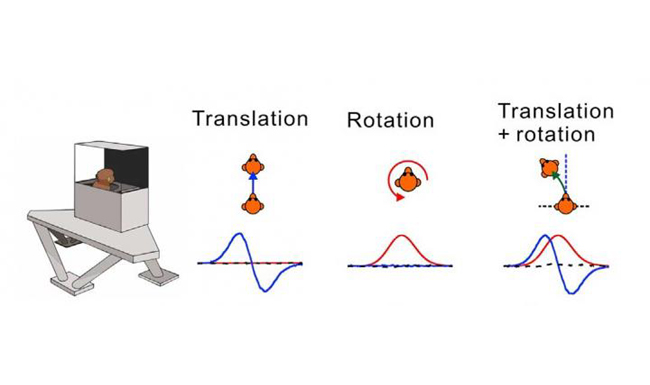
AsianScientist (Apr. 28, 2016) – Any organism with a brain needs to make decisions about how it’s going to navigate through three-dimensional spaces. That’s why animals have evolved sensory organs in the ears to detect if they’re rotating or moving in a straight line. But how does an animal perceive curved motion, as in turning a corner?
One explanation, published in Cell Reports, from Chinese researchers studying macaques, is that curved motion is detected when sensory neurons in the brain receiving converging information about linear and rotational movement are activated.
The parts of the ear that help macaques and humans detect motion are the same ones that help us stay balanced. Otoliths are sphere-like organs that detect linear motion and gravitational pull. In contrast, semi-circular canals specifically detect rotational movement. Information about an animal’s motion collected by these organs are then sent to the central nervous system in the brain.
It’s currently known that two distinct sets of neurons help us sense linear and rotational movement, but the new study has identified a third set of neurons in the macaque sensory cortex that respond optimally to curved motion.
“It’s a very interesting question as to why our brain evolved this way,” said corresponding author Professor Gu Yong, a neuroscientist at the Shanghai Institutes for Biological Sciences, Chinese Academy of Sciences.
“We don’t have to have these curved motion neurons in the sensory area of the brain; the information about translation and rotation could have converged at a higher level, e.g. association cortex which is important for sensory-motor transformation and decision-making.”
“Our hunch is that representation of curved motion in sensory cortex helps animals rapidly detect this type of movement, and save the working load of the decision centers for other important neural computations.”
Gu and lab member Dr. Cheng Zhixian made their discovery by putting macaques on moving platforms and attaching brain electrodes to individual neurons to measure how often and when they fired.

“People have known that linear and rotational motion converged in the sensory cortex, and we found that certain neurons fire more spikes when the linear or rotational information are available at the same time for these neurons,” Gu said.
“This might have been expected, but we now propose that these neurons could represent curvilinear motion.”
The experiments also mimicked a 1997 human study in which subjects were passively moved in various motion conditions (e.g curvilinear motion versus moving in a straight line while rotating the body) and reported analogous curved-motion sensation as long as both linear and rotation signals are present simultaneously.
The current macaque neurophysiological data show extremely similar patterns, and thus could account for the human psychophysical data.
“This is surprising,” Gu said. “In nature, we should be able to tell these two different types of motion during active navigation. Other signals in the brain, for example, the motor command signals, may help.”
The past decade has seen a surge in papers on how the body senses motion, and Gu believes there are more surprises to come. In particular, he’s interested in learning how other sensory systems play a role in how primates know where they are going.
The article can be found at: Cheng and Gu (2016) Distributed Representation of Curvilinear Self-Motion in the Macaque Parietal Cortex.
———
Source: Cell Press; Photo: Linda Tanner/Flickr/CC.
Disclaimer: This article does not necessarily reflect the views of AsianScientist or its staff.












